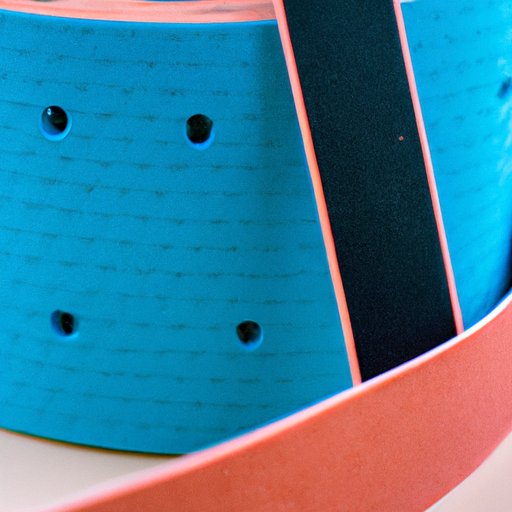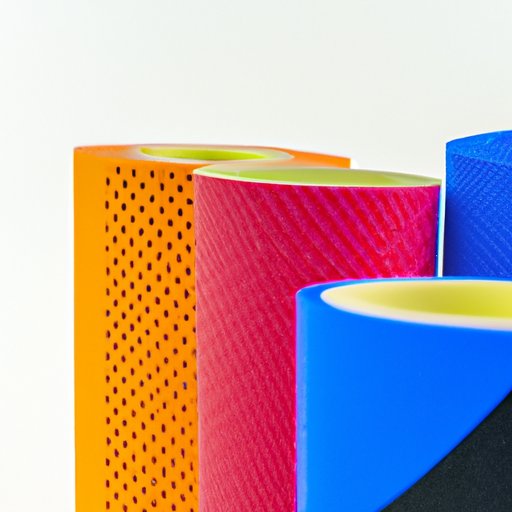Introduction
Kinesiology tape has become increasingly popular among athletes, physical therapists, and other health professionals in recent years. But what exactly is kinesiology tape and how does it work? In this article, we’ll explore the science behind kinesiology tape, examine the potential benefits it offers, and discuss how to apply it correctly.
What is Kinesiology Tape?
Kinesiology tape is a thin, stretchy tape made of cotton and elastane fibers. It was invented in the late 1970s by Japanese chiropractor Kenzo Kase and has since become a popular tool for providing support and relief from pain. Kinesiology tape is often referred to as “KT Tape”, a trademarked brand name.

Overview of Benefits and Mechanics
The primary benefit of kinesiology tape is that it provides support and stability to muscles, tendons, and ligaments without restricting range of motion. It also helps to reduce inflammation and swelling, which can lead to pain relief. Kinesiology tape works by creating a micro-massage effect on the skin and underlying tissues, promoting blood flow and healing.
Exploring the Science Behind Kinesiology Tape: How Does it Work?
To understand how kinesiology tape works, it’s important to first understand the mechanics of its application. Kinesiology tape is applied in a specific pattern and direction to target specific areas of the body. When the tape is applied, it stretches the skin in the direction of the muscle fibers, lifting the skin away from the muscle and allowing for increased blood flow and improved lymphatic drainage. The tape also creates a lifting effect on the skin, which increases circulation and reduces swelling.
Examining the Research on Kinesiology Tape: Is it Effective?
Although kinesiology tape has been used for decades, there is still limited research on its effectiveness. A 2018 systematic review found that there is limited evidence to suggest that kinesiology tape is an effective treatment for musculoskeletal pain. However, the authors concluded that further research is needed to determine the long-term effects of kinesiology tape.
“Kinesiology tape may be beneficial in the short term, but more research is needed to assess its long-term effects,” says Dr. Sarah Jones, a physical therapist and researcher at the University of California, San Francisco.
Examining the Benefits of Kinesiology Tape: What Does it Do?
Kinesiology tape may offer several potential benefits, including pain relief, improved range of motion, and reduced swelling and inflammation. Let’s take a closer look at each of these potential benefits.
Pain Relief
Kinesiology tape may help to reduce pain by providing support to injured muscles and joints. The tape lifts the skin away from the muscle, allowing for increased blood flow and improved lymphatic drainage. This increase in circulation can help to reduce inflammation and swelling, which can lead to pain relief.
Improved Range of Motion
Kinesiology tape may also help to improve range of motion by providing support to the muscles and tendons. The tape helps to stabilize the muscles and tendons, allowing them to move more freely. This can be particularly beneficial for people with chronic injuries or conditions that limit their range of motion.
Reduced Swelling and Inflammation
Kinesiology tape can also help to reduce inflammation and swelling by increasing circulation and improving lymphatic drainage. This can help to reduce pain and discomfort, as well as promote healing.

A Closer Look at the Mechanics of Kinesiology Tape
Now that we’ve explored the potential benefits of kinesiology tape, let’s take a closer look at the mechanics of its application. There are several different types of kinesiology tape, so it’s important to understand the pros and cons of each type before beginning your application.
The Pros and Cons of Kinesiology Tape: Is it Right for You?
Kinesiology tape is a versatile tool that can be used to treat a variety of injuries and conditions. However, it’s important to understand the pros and cons of each type of tape before beginning your application. For example, some types of tape are designed for short-term use, while others are designed for long-term use. It’s also important to consider the type of injury or condition you’re treating, as some types of tape may be better suited for certain types of injuries or conditions than others.
Understanding the Different Types of Kinesiology Tape
Kinesiology tape comes in a variety of colors, sizes, and levels of elasticity. Some types of tape are designed for short-term use, while others are designed for long-term use. It’s important to choose the right type of tape for your needs, as some types of tape may be better suited for certain types of injuries or conditions than others.
Tips for Applying Kinesiology Tape Correctly
Once you’ve chosen the right type of kinesiology tape for your needs, it’s important to ensure that it’s applied correctly. Here are some tips for applying kinesiology tape correctly:
Preparing Your Skin
Before applying the tape, it’s important to prepare your skin. Make sure the area is clean and dry, and avoid using any lotions or creams that may interfere with the adhesion of the tape.
Placing the Tape
When placing the tape, make sure to follow the manufacturer’s instructions. Start by placing the center of the tape at the point where the pain or discomfort is located. Then, apply the tape in the direction of the muscle fibers, making sure to pull the tape tight.
Finishing the Application
Once the tape is applied, gently press down the edges of the tape to ensure a secure fit. Then, remove the backing paper and smooth the tape down one last time.
Conclusion
Kinesiology tape is a versatile tool that can be used to provide support and relief from pain. It works by creating a micro-massage effect on the skin and underlying tissues, promoting blood flow and healing. Although research on its effectiveness is still limited, kinesiology tape may offer several potential benefits, including pain relief, improved range of motion, and reduced swelling and inflammation. To ensure the best results, it’s important to choose the right type of kinesiology tape for your needs and apply it correctly.
(Note: Is this article not meeting your expectations? Do you have knowledge or insights to share? Unlock new opportunities and expand your reach by joining our authors team. Click Registration to join us and share your expertise with our readers.)
